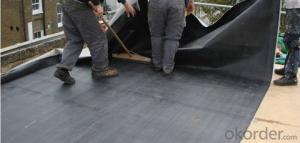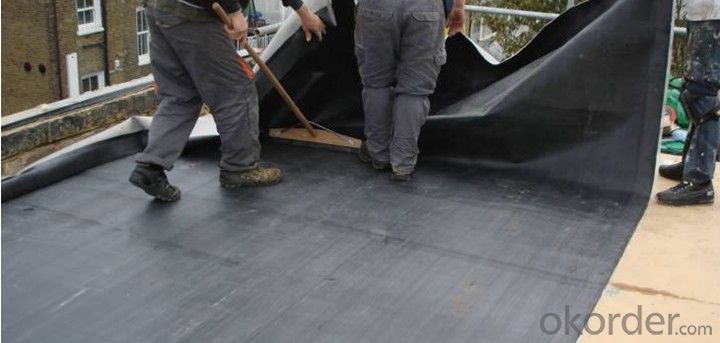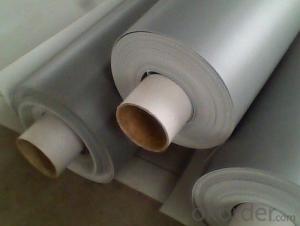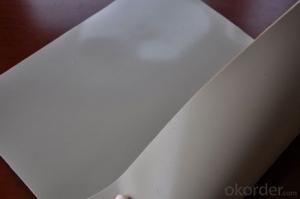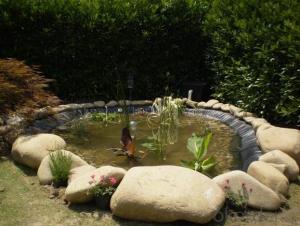EPDM Rubber Waterproof Membrane for Green Roof
- Loading Port:
- Shanghai
- Payment Terms:
- TT OR LC
- Min Order Qty:
- 50000 m²
- Supply Capability:
- 5000000 m²/month
OKorder Service Pledge
OKorder Financial Service
You Might Also Like
EPDM Rubber Waterproof Membrane for Green Roof
Description Of EPDM Rubber Waterproof Membrane for Green Roof:
This waterproof coiled material is of high elasticity with best performance among high polumer waterproof coiled material in the world.It is also the most typical one in the world.Waterproof coiled material made of ternary ethylene-propylene rubber is produced with the use of the most advanced contiuous extrusion and vulcanization technology and related equipments which are specially designed for production of such product.It is good in compactness,without bubble and performance difference in length and breadth,perfomances reach or exceed the demands of GB18173.1-2000 standard.
Main Features of EPDM Rubber Waterproof Membrane for Green Roof:
1.EPDM waterproof membrane for bridge engineering waterproof
2.EPDM waterproof membrane for water conservancy projects ,such as river bank,lake dam seepage.
3.EPDM waterproof membrane for the municipal engineering.
4.EPDM waterproof membrane for aquaculture.
Specifications of EPDM Rubber Waterproof Membrane for Green Roof:
| Number | Item | Unit | Value | |
| 1 | Size Variation | Thichness | % | ±10 |
| Width | % | ±1 | ||
| Length | % | Allowed negative | ||
| 2 | Breaking tensile strength at normal temperature | Mpa | ≥7.5 | |
| Breaking tensile strength at 70°C | Mpa | ≥2.3 | ||
| 3 | Breaking elongation at normal temperature | % | ≥450 | |
| Breaking elongation at -20°C | % | ≥200 | ||
| 4 | Tear strength | KN/m | ≥25 | |
| 5 | Impermeability(30min) | * | 0.3Mpa no leakage | |
| 6 | Bending at low tempreture | °C | ≤-40 | |
| 7 | Stretch tensor at heating | Elongate | mm | ≤2 |
| Shrink | mm | ≤4 | ||
| 8 | Air oven aging(80°C×168h) | Tensile strength at break retained | % | ≥80 |
| Elongation at break retained | % | ≥70 | ||
| 9 | Anti-alkali | Tensile strength at break retained | % | ≥80 |
| Elongation at break retained | % | ≥80 | ||
| 10 | Nuture weathing at manual simulation | Tensile strength at break retained | % | ≥80 |
| Elongation at break retained | % | ≥70 | ||
Applications of EPDM Rubber Waterproof Membrane for Green Roof:
Widely used in roofs, basement, toilet ,swimming pool, and all kinds of industry and civil building waterproofing, reservoir, vivicism, bridge, underground, tunnel and dam waterproofing ,especially to the keystone waterproofing projects which is durability, high corrosion resistance and easy deformation.



IMages of EPDM Rubber Waterproof Membrane for Green Roof:




FAQ of EPDM Rubber Waterproof Membrane for Green Roof:
1. What are we supplying?
We are specialized in producing Colorful Asphalt Roof Shingle, SBS/APP modified bitumen waterproof membrane, Self adhesive bitumen waterproof membrane, PVC waterproofing membrane, EPDM rubber roofing membrane, Single Component Polyurethane Waterproof Coating, and Spray Polyurea Waterproof Coating
.
2. How Many years experience do we have?
We have been exported to more than 20 countries in the past 15 years.
3. How long do we usually reply your request?
We always reply our customer within 24 hours.
- Q: Can a waterproofing membrane be used for underground electrical vaults?
- Using a waterproofing membrane is highly recommended for underground electrical vaults in order to maintain the integrity and functionality of the electrical equipment. Underground electrical vaults are prone to water infiltration, which can lead to damage and compromise the functionality of the electrical equipment. Waterproofing membranes serve as a barrier against water and moisture, effectively preventing water from entering the vault. These membranes are specifically engineered to be highly durable and resistant to water penetration, providing long-term protection for the electrical equipment within the vault. Additionally, waterproofing membranes help prevent corrosion and extend the lifespan of the electrical vaults. Therefore, it is advisable to utilize a waterproofing membrane for underground electrical vaults.
- Q: What type of maintenance is required for a waterproofing membrane?
- Regular maintenance is required for a waterproofing membrane to ensure its effectiveness and longevity. This maintenance typically includes inspecting the membrane for any signs of damage, such as cracks or tears, and promptly repairing them. Additionally, it is important to keep the membrane clean and free from debris to prevent clogging or blockages. Regular inspections and maintenance will help to extend the life of the waterproofing membrane and ensure it continues to effectively protect the underlying structure.
- Q: Does a waterproofing membrane require a primer before application?
- In order to apply a waterproofing membrane, it is necessary to use a primer. The purpose of a primer is to improve the adhesion between the membrane and the substrate, guaranteeing a strong bond. Additionally, it acts as a sealant that protects the surface, preventing any moisture or impurities from affecting the efficiency of the waterproofing system. For a reliable and enduring waterproofing solution, it is crucial to apply a primer prior to the membrane.
- Q: What is the difference between polymer waterproofing membrane and cross film waterproofing membrane?
- he strong cross-over film of the product is a high-strength HDPE film formed by the cross-laminating process. The film and the like have the same vertical and transverse elongation ratio. The coil does not send deformation, more beautiful and waterproof reliable.
- Q: Can a waterproofing membrane be used for highway or road projects?
- Yes, a waterproofing membrane can be used for highway or road projects. Waterproofing membranes are commonly used in road construction to protect the underlying layers from water damage. These membranes act as a barrier against water infiltration, preventing water from seeping into the road structure and causing deterioration. They are typically applied on the bridge decks, tunnels, retaining walls, and other areas where water exposure is high. The waterproofing membrane helps to extend the lifespan of the road by preventing moisture-related issues such as cracks, potholes, and erosion. Additionally, it can enhance the durability and strength of the road structure, improving its resistance to environmental factors. Overall, the use of a waterproofing membrane in highway or road projects can provide long-term protection and ensure the longevity of the infrastructure.
- Q: Can a waterproofing membrane be used for a basement floor slab?
- Yes, a waterproofing membrane can be used for a basement floor slab. A waterproofing membrane is designed to prevent water and moisture from seeping into the surface it is applied to. This makes it an ideal solution for protecting basement floor slabs from potential water damage. By installing a waterproofing membrane on the basement floor slab, you can create a barrier that effectively prevents water penetration, reducing the risk of water damage, mold growth, and structural issues. Additionally, a waterproofing membrane can also serve as a vapor barrier, preventing moisture from rising up through the slab and causing issues such as dampness or high humidity levels in the basement. Overall, using a waterproofing membrane for a basement floor slab is a smart choice to ensure the long-term durability and protection of the basement.
- Q: What is the warranty or guarantee for a waterproofing membrane?
- The warranty or guarantee for a waterproofing membrane can vary depending on the manufacturer and product. Generally, a waterproofing membrane should come with a warranty that guarantees its performance and durability. This warranty typically covers defects in materials or workmanship and ensures that the membrane will remain waterproof for a certain period of time. The length of the warranty can range from a few years to several decades, depending on the quality and type of the membrane. Some manufacturers may offer a limited warranty, which means that certain conditions or limitations apply. For example, the warranty may only cover the replacement of the membrane itself, excluding any additional costs such as labor or damage to other parts of the structure. It is important to carefully read and understand the terms and conditions of the warranty before purchasing a waterproofing membrane. This will give you a clear understanding of what is covered and what is not, as well as any specific requirements or maintenance guidelines that need to be followed to maintain the warranty validity. In addition to the warranty provided by the manufacturer, it is recommended to choose a reputable and experienced contractor for the installation of the waterproofing membrane. Many contractors also offer their own warranty or guarantee on their workmanship, which can provide an additional layer of protection and assurance. Overall, the warranty or guarantee for a waterproofing membrane is an important factor to consider when selecting a product. It provides peace of mind and ensures that you are protected against any potential defects or failures in the membrane, giving you confidence in the long-term performance and durability of your waterproofing system.
- Q: Can a waterproofing membrane be used in kitchens?
- Yes, a waterproofing membrane can be used in kitchens. In fact, it is highly recommended to use waterproofing membranes in areas prone to moisture and water exposure, such as kitchens. These membranes are designed to create a barrier against water and prevent it from seeping into the underlying structure, protecting it from damage. They are commonly used on floors, walls, and even countertops to ensure a watertight seal and prevent water damage, mold growth, and other issues. Additionally, waterproofing membranes can also help with soundproofing and provide added durability and longevity to the kitchen surfaces.
- Q: Can a waterproofing membrane be used in areas with heavy foot traffic or vehicle loadings?
- Yes, a waterproofing membrane can be used in areas with heavy foot traffic or vehicle loadings. However, it is important to ensure that the membrane selected is designed specifically for such conditions and is capable of withstanding the expected loads and pressures. Additionally, regular maintenance and inspections are necessary to ensure the membrane remains intact and functional in high-traffic areas.
- Q: Asphalt composite tire flexible membrane is SBS
- SBS waterproofing membrane implementation of standards: GB 18242 (2008) "elastomer modified asphalt waterproofing membrane" Asphalt composite tire flexible membrane implementation of the standard: JCT 690 (2008) "asphalt composite tire flexible waterproofing membrane" Sometimes the composite tire coil also refers to several other rubber modified membrane.
Send your message to us
EPDM Rubber Waterproof Membrane for Green Roof
- Loading Port:
- Shanghai
- Payment Terms:
- TT OR LC
- Min Order Qty:
- 50000 m²
- Supply Capability:
- 5000000 m²/month
OKorder Service Pledge
OKorder Financial Service
Similar products
Hot products
Hot Searches
Related keywords
